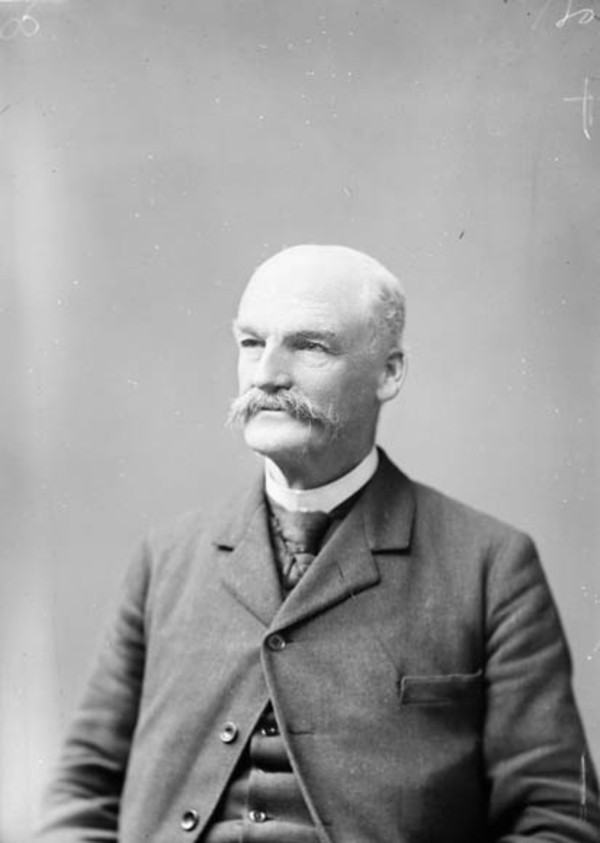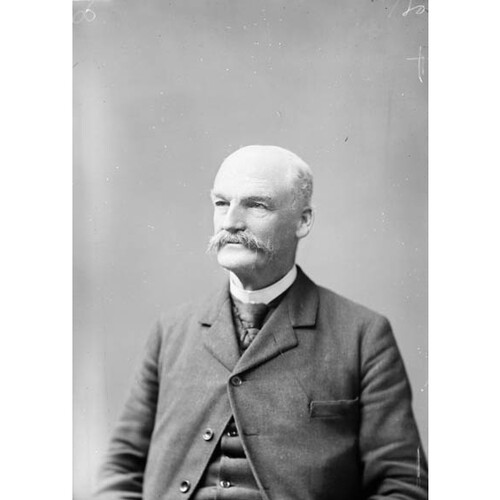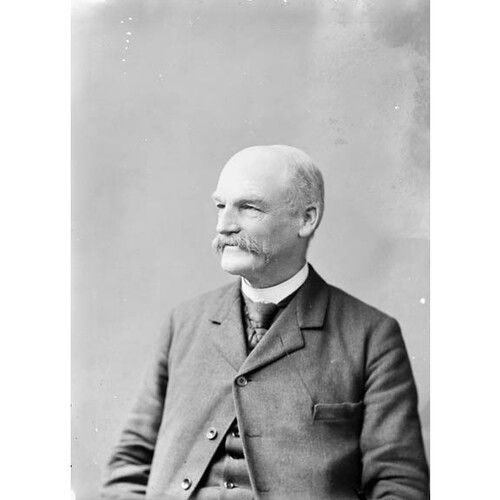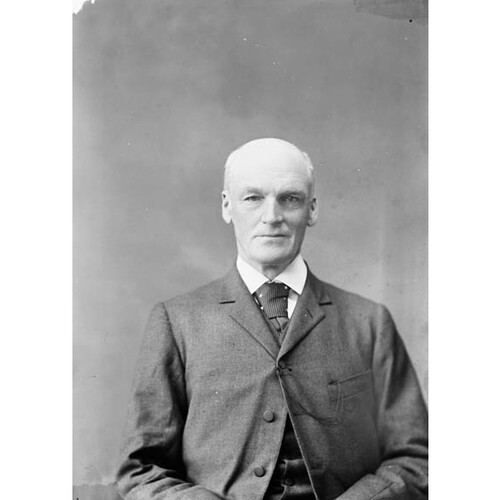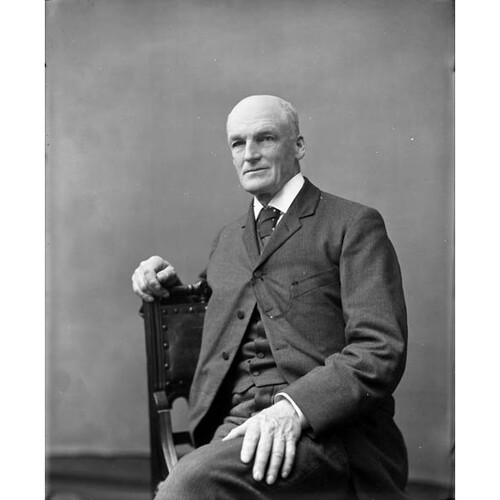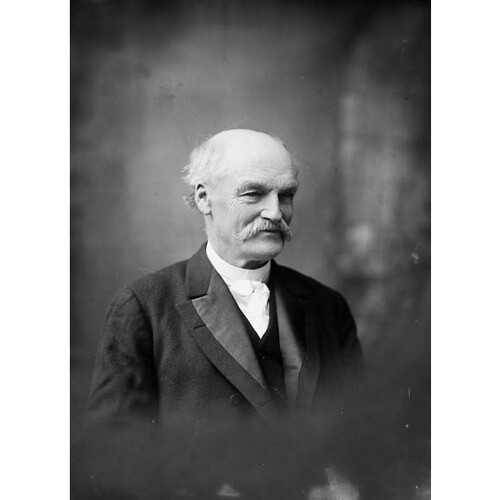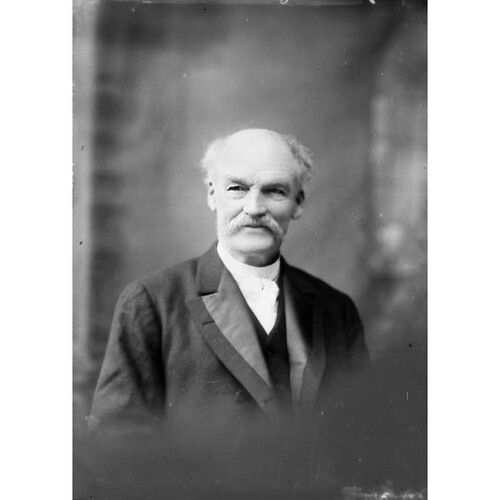SCHREIBER, Sir COLLINGWOOD, engineer and civil servant; b. 14 Dec. 1831 in Bradwell-on-Sea, England, fourth son of the Reverend Thomas Schreiber and Sarah Bingham; m. first 9 July 1856 Caroline MacLean (d. 1892) in Scarborough Township, Upper Canada, and they had four daughters and a son; m. secondly 14 Nov. 1898, in Ottawa, Julia Maude Gwynne, daughter of John Wellington Gwynne*; d. there 23 March 1918.
Trained as a surveyor and engineer in England, Collingwood Schreiber immigrated to Toronto with his family in 1852 and joined the engineering staff of the Hamilton and Toronto Railway. In 1856 he entered private practice with Sandford Fleming; four years later Schreiber left to work as superintending engineer of construction for the Northern Railway. On 1 May 1864 he received his first government appointment, in Nova Scotia, as a part-time divisional engineer on the intercolonial railway project and for the Eastern Extension Railway to Pictou. He was made a full-time sectional engineer for the Intercolonial Railway on 1 Oct. 1868, by which time it had become a federal project, with Fleming as engineer-in-chief. At the end of 1871 Schreiber assumed the position of district engineer for the Intercolonial at Amherst. Displaying the engineering-based pattern of decision-making that would mark his career, he supported Fleming’s choice of the Folly Lake route through the Cobequid Mountains in Nova Scotia because of its engineering advantages rather than the Madison Brook route, which offered only local political advantages. In October 1873 Schreiber became chief engineer for all government railways in operation. Privately, beginning in 1871, he had also undertaken contracting work for the Prince Edward Island Railway, parts of it in partnership with Isaac Burpee*.
Schreiber subsequently dedicated himself to the railway dream of Prime Minister Sir John A. Macdonald*. He appreciated the immense engineering challenges posed by the mountainous west, but felt that Canada could not prosper without additional steel. In June 1880 he replaced Fleming as chief engineer of the Canadian Pacific Railway; the following month he became general manager of all government railways in operation, working out of the newly formed Department of Railways and Canals in Ottawa [see Sir Charles Tupper]. He defined his duties as seeing that the country’s “roads are operated with economy, and the business conducted with despatch.” Responsible for controlling construction costs on the CPR, he played a large part in determining railway tariffs and the conditions of government financing. In January 1884, for example, his suggestions on a major loan to the CPR helped secure the government against loss and allow the CPR to continue construction. His numerous inspection tours, including an 82-mile trek in June over difficult terrain north of Lake Superior with general manager William Cornelius Van Horne, who became a close friend, also contributed to the railway’s completion in 1885.
Schreiber’s administration as chief engineer was efficient and economical. He disliked politicians meddling in engineering decisions and tolerated patronage grudgingly. Although he was not above finding a job for a nephew of one of Macdonald’s acquaintances, he stated unequivocally in 1880 before the royal commission on the civil service that in his department promotion depended on merit. Some within the government, among them Minister of Justice John Sparrow David Thompson*, saw Schreiber and his minister in 1884–89, John Henry Pope*, as an abrasive, authoritarian duo who rarely granted favours.
Upon the retirement of Toussaint Trudeau* as deputy minister, Schreiber took over the position on 1 Dec. 1892. At the same time the Privy Council combined the engineering responsibilities for canals and railways into one position, which Schreiber assumed as well. A scrutinizer of the first order, he believed that public servants must act, he wrote in 1892, “with due regard to economy, always bearing in mind that the great art is to perform a service well, at the least possible cost, extravagant management is not skillful management.” He sanctioned even the minor decisions made by his staff, reorganized the department, reduced personnel, and limited expenditures. As the responsibilities of his department expanded with the growth of Canada’s rail network, however, he continuously appealed for an “amplification” of his staff between 1899 and 1903. A founding member of the Canadian Society of Civil Engineers in 1887, he had been made a cmg in 1893 for his work.
Schreiber retained his positions as deputy minister and chief engineer when the Liberals took office in 1896 under Wilfrid Laurier. At first his relationship with Laurier seemed strained, but it warmed as the government’s part in the financing and construction of the National Transcontinental Railway progressed [see Charles Melville Hays]. On 1 July 1905 his replacement as deputy and chief engineer by Matthew Joseph Butler* allowed Schreiber, then 73, to assume the specially created government post of consulting engineer on the western or Grand Trunk Pacific division of the NT. This inspectorship would again prove his devotion to feasibility over expedience and to controlling government investment. In 1905–6 Schreiber and GTP officers clashed over the route through the Rockies; he was equally rigorous in his dealings with the Canadian Northern in its construction of a rival transcontinental. No friend of contractors, he was disappointed with the slow construction of the GTP and the shortage of willing workers, and he favoured the importation of non-white labour to expedite its completion. Schreiber was critical too of organized labour. During a disruption on the GTP in 1912, construction workers and the western press both chastised him for his weak appreciation of the issues involved. After the GTP was opened for through traffic in 1914, he continued in government employ as a general consulting engineer.
A large man whose stamina never seemed to diminish with age, in October 1913 Schreiber had undertaken an inspection tour of the GTP, including the traverse of a 214-mile gap by three small boats and a buggy. In his published memoirs of 1914, Sir Charles Tupper, who as minister of railways and canals had worked with Schreiber on the construction of the CPR, stated that “in all my career I never met an individual gifted with so great a love of, or capacity for, work.” Created a kcmg in 1916, Schreiber remained active in the affairs of government railways until his death from cancer in 1918 at Elmsleigh, his Ottawa home.
Sir Collingwood Schreiber’s engineering expertise, coupled with his effective administrative skills, accelerated completion of the CPR and the GTP His participation in the national dream stands as his most significant contribution to the country’s economic and regional development.
AO, F 647, MU 2664, 2669, 2678, 2685–88, 2720–22; RG 22-354, no.8628; RG 80-5-0-266, no.3972; RG 80-8-0-659, no.12700. Essex Record Office (Chelmsford, Eng.), T/R 56 (RBMB, Bradwell-on-Sea), 14 Jan. 1832 (transcript). NA, MG 26, A; D; F; G; H; MG 28, III 20, Van Horne letterbooks; RG 11, B1(d); B2; RG 43, AIII, 1; BIV, 2, esp. vol.1835: 739; RG 55, 20011: 145–46. Globe, 15 July 1856. Can., Parl., Sessional papers, 1867/68–1919, civil service lists, 1885–1918; reports of the minister of public works, 1866–79, and of the Dept. of Railways and Canals, 1880/ 81–1917/18. Can., Prov. of, Parl., Sessional papers, 1861–66, reports of the commissioner of public works, 1860–65. Canada’s smallest province: a history of P.E.I., ed. F. W. P. Bolger (Charlottetown, 1973). Canadian men and women of the time (Morgan; 1898 and 1912). Correspondence between the provincial government, Messr. Schreiber & Burpee, contractors for building the Prince Edward Island Railway and Thomas Swinyard . . . (Charlottetown, 1875). CPG, 1887, 1897. Sandford Fleming, The Intercolonial: a historical sketch of the inception, location, construction and completion of the line of railway uniting the inland and Atlantic provinces of the dominion (Montreal and London, 1876). Lorne Green, Chief engineer: life of a nation builder – Sandford Fleming (Toronto, 1993). H. A. Innis, A history of the Canadian Pacific Railway (Toronto, 1923; repr. Toronto and Buffalo, NY, 1971). Frank Leonard, A thousand blunders: the Grand Trunk Pacific Railway and northern British Columbia (Vancouver, 1996). Railway and Shipping World (Toronto), 1 (1898): 113. T. D. Regehr, The Canadian Northern Railway, pioneer road of the northern prairies, 1895–1918 (Toronto, 1976). H. G. Schreiber, “Schreiber pedigree” (typescript, [Toronto], 1960; copy in DCB library). G. R. Stevens, Canadian National Railways (2v., Toronto and Vancouver, 1960–62). Charles Tupper, Recollections of sixty years in Canada (Toronto, 1914). Waite, Man from Halifax.
Cite This Article
Sean Gouglas, “SCHREIBER, Sir COLLINGWOOD,” in Dictionary of Canadian Biography, vol. 14, University of Toronto/Université Laval, 2003–, accessed December 12, 2025, https://www.biographi.ca/en/bio/schreiber_collingwood_14E.html.
The citation above shows the format for footnotes and endnotes according to the Chicago manual of style (16th edition). Information to be used in other citation formats:
| Permalink: | https://www.biographi.ca/en/bio/schreiber_collingwood_14E.html |
| Author of Article: | Sean Gouglas |
| Title of Article: | SCHREIBER, Sir COLLINGWOOD |
| Publication Name: | Dictionary of Canadian Biography, vol. 14 |
| Publisher: | University of Toronto/Université Laval |
| Year of publication: | 1998 |
| Year of revision: | 1998 |
| Access Date: | December 12, 2025 |


